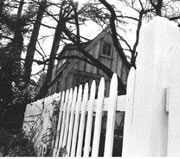BRUCE AND PAIGE Clark’s roomy two-story Queen Anne Hill house features plank floors, board-and-batten exterior, a small deck, and a peekaboo view of the harbor.
Like most houses, it also has a shingled roof, gutters and downspouts, full-size doors and windows, running water, and an electrical hookup.
But it’s patently unlike most houses. For one thing, the $15,000 structure is the Clark family’s elaborate children’s playhouse, nestled in a corner of their raised front yard overlooking 11th Avenue West.
For another, the playhouse is 16 feet tall at its peaked roof, big enough, apparently, to be an eyesore in the opinion of a neighbor, who filed an anonymous complaint with the city.
That led to the arrival of a city inspector and turned the kiddie dream house into the parents’ nightmare.
Now the Clarks must tear it all down, from its custom skylight to its concrete foundation, or be hit with potential $150-a-day fines.
Bloodied but unbowed, the Clarks are resisting, although the couple think they know where they went wrong. “It has all been so Kafka-esque,” says Bruce Clark, a Seattle attorney and father of two boys. “The further you delve into the bureaucracy, the more you encounter someone who tells you something different.”
The Clarks say that from the beginning, they painstakingly sought permits, reviewed building and zoning codes, and queried inspectors to make sure they were legally erecting what Bruce Clark calls the “special gift” to his boys.
Records indicate the city’s department of Design, Construction, and Land Use (DCLU) seemed confused at first about how to classify the oversize playhouse, but did give a thumbs-up to the project. Clark’s contractor brother began erecting the structure last June.
To make sure there was no confusion, one inspector wrote “exempt” on her business card and handed it to Paige, confirming that standard building codes did not apply to a children’s plaything.
Then someone objected, and a new inspector showed up, her husband says.
He doesn’t know who complained, and City Hall won’t tell him. “The complaint process works great if you’re a complainer,” says Clark. “They carry all the weight.”
A neighbor down the street says he suspects the complainant may be the fellow hilltopper who told him the playhouse was a wretched excess, “considering how many adults go homeless.” A resident across the street from the Clarks wonders how anyone could object. “They built it so all the kids in the neighborhood could use it,” she says.
In September, when the playhouse was essentially complete, the city reaffirmed that building codes don’t apply to playhouses—but land-use codes do.
And under those laws, the 300-square-foot playhouse encroached too far into the front and side yards and exceeded the 12-foot height limit for such structures, the city said.
In November, a citation was issued. The once-approved playhouse would have to come down or be moved.
A few weeks ago, a city hearing examiner sided with the DCLU. Examiner Meredith Getches, responding to an appeal filed by Clark, affirmed a city fine of $150 and left the door open for similar amounts to be levied daily as long as the playhouse remains.
“We wanted it to be solid, safe, and quakeproof so our kids couldn’t get hurt,” says Clark. “What this decision says is: Too bad, you should have built a crappy little half-ass structure and that would have been fine.”
In her Jan. 29 decision, Getches seemed to agree that the DCLU gave the Clarks sometimes misleading construction information and at first even charged them with breaking the wrong law.
But the department is admitting nothing. It won’t comment on the ruling or Bruce Clark’s claims, although spokesperson Alan Justad says, “We have not changed our position. The playhouse does not conform with single-family [neighborhood] zoning requirements. . . .”
Clark says he’s still not sure what to make of it all. “Even at the hearing [in January], three different DCLU officials gave three different interpretations of the land-use code.”
So will the Clarks dismantle their kids’ superhouse?
“It’s entirely possible we may spend many thousands to move it,” Clark says. “The only place it can now lawfully exist is as an attachment to our own house.”
But the attorney is also staking out some legal ground. Last month he filed an appeal in Superior Court, seeking review of the hearing examiner’s decision and, he hopes, a reversal of her ruling.
“I’d like a judge to see the evidence,” Clarks says. “In one letter to us, DCLU said, in essence, we understand we may have told you one thing, but it’s your responsibility to know we meant something else.
“I’m just thankful we weren’t building a downtown skyscraper.”








